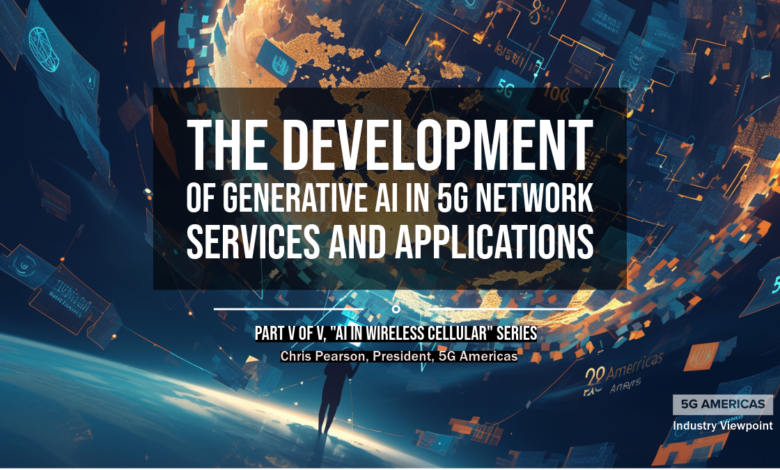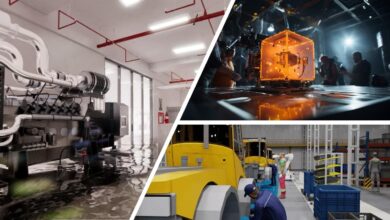The Development of Generative AI in 5G Network Services and Applications

This is Part V of a five-part blog series on AI/ML in 5G and future wireless cellular networks. Part I, Part II,Part III, and Part IV are here.
Chris Pearson, President, 5G Americas (May 2024) – Over the past few weeks, I’ve written about the impact of generative AI on 5G networks. The potential scale of these impacts could be staggering, ranging from network planning, spectrum management, enhanced user experiences via content optimization, virtualization, network slicing, as well as predictive maintenance and security. Truly, there does not seem like any area of the wireless cellular network that might not be impacted by these tremendous technologies. In the final blog post, I’m pulling the focus back out of the weeds and bringing it up to a big picture level by looking at how the convergence of artificial intelligence (AI) and 5G technology can potentially unlock new opportunities across various sectors.
There is much potential for these technologies to streamline logistics, traffic management, agriculture, entertainment, and environmental monitoring, promising transformative changes in urban centers and remote locations alike. AI not only enhances the operational efficiencies of 5G networks but could also enable a host of new applications and services that were previously unimaginable. From smart cities to autonomous vehicles and beyond, AI leverages the high speed and low latency of 5G to unlock transformative opportunities, reshaping how we interact with technology daily.
Generative AI’s integration into 5G networks could be pivotal for their optimization and reliability. Through advanced predictive maintenance, AI systems can analyze vast amounts of data in real time, predicting and preemptively addressing potential network failures or malfunctions. Generative AI also could play a crucial role in network behavior modeling, where it simulates complex network environments to predict the impact of various changes, user behaviors, and scaling scenarios. These simulations help network engineers and planners optimize the deployment and scaling of 5G networks, ensuring that they can handle expected loads and adapt to user demands dynamically.
For instance, in Singapore the application of 5G-enabled drones has moved from theory to practice, significantly enhancing both delivery and surveillance operations. M1’s deployment of drones to deliver medical supplies from shore to ships illustrates how 5G’s high-speed and low-latency capabilities are crucial in managing complex logistics operations. These drones can dynamically adjust their flight paths based on real-time environmental data, traffic updates, and immediate logistical needs, ensuring timely and secure deliveries. In surveillance, these drones leverage AI to autonomously monitor and analyze high-definition video feeds, identifying unauthorized entries or suspicious activities, and immediately alerting security personnel without human intervention.

Governments like India and municipalities such as City of Barcelona are also beginning to leverage AI to transform their traffic management systems. These systems utilize extensive data from sensors and cameras to dynamically manage traffic flow, significantly reducing congestion and enhancing emergency response. For instance, during emergencies or peak traffic hours, the systems adjust traffic signals to prioritize routes for emergency vehicles, thereby reducing response times and improving public safety. This smart management not only eases traffic flow but also contributes to environmental sustainability by reducing emissions from idling vehicles.
The National Highways Authority of India (NHAI) has unveiled a new policy aimed at improving road safety and shortening the time it takes to respond to incidents on the country’s highways and expressways. This effort utilizes cutting-edge artificial intelligence (AI) technology and emphasizes the digital enforcement of traffic laws. In line with these enhancements, the older VIDS cameras are being upgraded to the newly created Video Incident Detection and Enforcement System (VIDES). While the ATMS equipment will initially use OFC for communication with the Command & Control Centers, the policy also anticipates future integration of 5G-based communication tools as 5G coverage expands.


Barcelona’s use of digital twins, as highlighted in the collaboration with the Barcelona Supercomputing Center, leverages generative AI to simulate and predict urban planning outcomes. This ambitious project aims to redefine urban planning by using AI to create detailed simulations of the city. These simulations help in evaluating future scenarios, making political decisions, and assessing the feasibility of infrastructure projects or urban interventions. It is also field testing these ideas in open city-wide lab for the validation and adoption of 5G technologies and applications in a real-life environment through the innovative 5G Barcelona project.
In the American Midwest, AI and 5G are beginning to revolutionize farming with precision agriculture. This technology allows for the real-time monitoring of various agricultural metrics, such as soil moisture levels, crop health, and environmental factors, enabling farmers to make informed decisions on resource application. This data-driven approach helps in precisely applying water, fertilizers, and pesticides, optimizing resource use, and boosting crop yields while minimizing environmental impact. Such targeted management practices lead to enhanced agricultural productivity and sustainability.
In one example, a 5G Americas member company, in cooperation with the U.S. National Science Foundation’s Platforms for Advanced Wireless Research (PAWR) program, launched a 5G SA network for public research at Iowa State University. This network supports precision agriculture applications and other research initiatives, connecting farm sites that previously had little to no broadband access. Initial precision agriculture research projects include using connected robots to collect plant phenotyping data and livestock monitoring.


Major events like music festivals like Tomorrowland are harnessing AI and 5G to offer unprecedented interactive and immersive experiences. These technologies enable real-time interactions for both attendees and remote viewers, such as choosing different camera angles, interacting with performers, or modifying the event’s visual and auditory elements. This level of engagement is transforming how audiences experience entertainment, making it more personalized and accessible to a global audience.
The Tomorrowland music festival has significantly enhanced its network performance through the deployment of 5G technology, particularly during the festival season. Local wireless operators and equipment vendors deployed additional high-speed 5G sites at more than 120 locations, offering a 20 percent network performance boost from normal coverage. Furthermore, BMW and Tomorrowland launched ‘Future Record,’ an interactive AI experience that allows music fans worldwide to create a track embodying their connection to Tomorrowland, showcasing the festival’s innovative use of generative AI in music.
Generative AI can be used to simulate and predict energy consumption patterns and grid conditions in real-time. This capability, combined with 5G’s high-speed and low-latency communication, allows for more precise and dynamic control of grid operations. This integration can help in balancing load, reducing outages, and increasing the efficiency of electricity distribution.
For instance, a collaboration involving MIT’s Laboratory for Information and Decision Systems (LIDS) and Tennessee Tech University showcases such a synergy. This project, supported by a $1,365,000 grant from the Appalachian Regional Commission, focuses on creating AI-driven generative models for customer load data as part of the Smart Grid Deployment Consortium (SGDC). These generative models are used for smart grid modeling and training algorithms for energy tech startups. The integration of 5G technology in this project enables the rapid transmission of large datasets and real-time analytics, crucial for the effective deployment of smart grid technologies and utility-scale battery storage in rural electric utilities.


Another innovative use of generative AI and 5G is in environmental health monitoring and prediction. The Amazon rainforest is benefiting from the deployment of AI and potentially future 5G-enabled devices that monitor environmental health and predict potential ecological threats. These systems enable real-time monitoring and provide rapid responses to threats such as illegal logging, helping to preserve this vital ecosystem. For instance, devices equipped with AI can detect the sound of chainsaws and unauthorized off-road vehicles, which are indicators of illegal deforestation activities. Specific technologies mentioned include the use of recycled mobile phones equipped with microphones to detect deforestation sounds, and advanced AI algorithms that process these audio signals to identify illegal logging activities. Additionally, drones and satellite imagery are used to monitor deforestation and other environmental changes.
This is a dynamic and exciting time for the wireless telecom sector. Like many industries, the wave of generative AI is starting to introduce new ways of doing business, causing disruption, but also potentially creating amazing new opportunities. Fortunately for telecom, the synergy between AI and cellular technologies are working together to re-shape innovative applications. The focus of the marriage of these two amazing technologies should be to provide solutions in many opportunistic areas including but not limited to industrial operations, environmental management, and urban living.
It’s an amazing time. I hope you’ve enjoyed this series of blog posts. I imagine there will be much more said about AI and 5G in the months and years ahead.
-Chris



